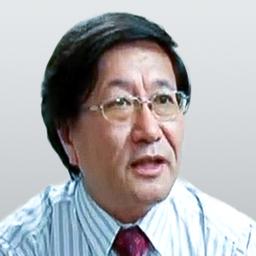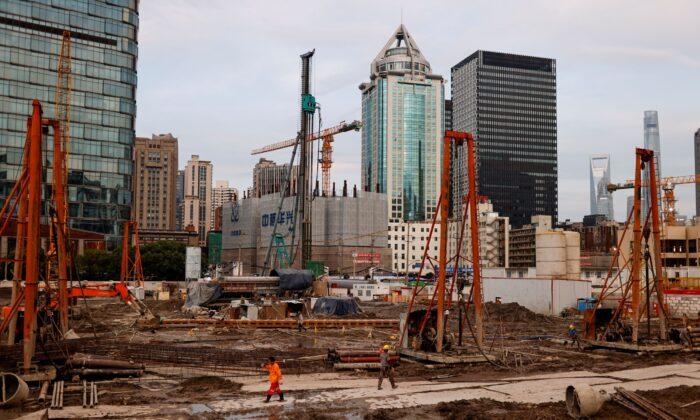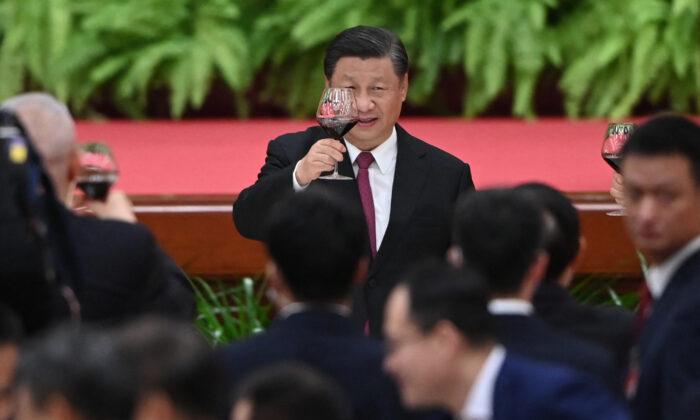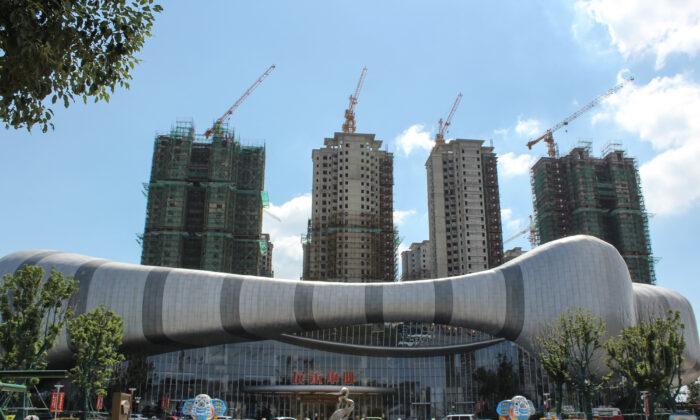The Chinese Communist Party (CCP) has surprised the international community by playing fast and loose in U.S.-China trade talks over the past two years.
Conclusions Drawn From Trade Negotiations
The U.S.-China trade talks reached a preliminary first phase agreement on Oct.11, but there has been much international skepticism about its validity. This is because China’s conduct in the negotiations over the past two years has left many in the international community worried about the CCP’s credibility. As the saying goes, it is easier to destroy integrity than to build it. The capricious and untrustworthy nature of the CCP during the U.S.-China negotiations has impressed all countries.The U.S.-China trade negotiations over the past two years can be divided into four stages. The first stage lasted until mid-May this year, and the two sides have conducted smooth negotiations. Due to the CCP’s repeated violation of WTO rules and international conventions on the protection of intellectual property rights, and infringement on the interests of the United States, Washington started negotiations on relevant issues.
The two sides basically reached agreement on all issues involved in the negotiations. The United States later revealed that the two sides had even finished punctuation marks on the text of the agreement, leaving only the signing process.
The second stage is from late May to late August 2019, entering the state of “toppling the negotiation table.” Trade talks were bogged down by China’s sudden refusal to sign what was essentially an agreed deal.
In the third stage, from late August to late September, the Chinese side announced a ban on imports of U.S. agricultural products, exerting pressure on the United States in an attempt to hurt Trump’s popularity by striking American agricultural industry.
In the fourth stage, from the end of September to the beginning of October, China suddenly made a U-turn and decided to double the amount of agricultural products imported from the United States as compared to 2017 in order to break the deadlock of the negotiations. The two sides reached a preliminary agreement on some economic and trade issues.
While the Chinese exhibited capricious behavior, the U.S. side’s attitude of seeking negotiation remained basically unchanged, except for imposing tariffs after China’s non-cooperation at the beginning of the negotiation. In other words, China’s about face is not a response to the back and forth of the American negotiating position, but a change of attitude based on China’s own interests. The shift from its attack on the United States to an overture may be based on two calculations.
First, as China’s economy continues to decline, continuing exports to the United States has become a matter of necessity which requires an immediate detente. Second, the CCP, judging that President Donald Trump is likely to win a second term, believes unwise to continue opposing him, so it needs to “heat the fire” (doubling the amount of American farm imports) before the U.S. presidential election.
Why is the CCP’s Attitude Towards WTO Regarded as ‘Misbehaving’?
It has been nearly 20 years since China joined the WTO, and many of the issues in today’s U.S.-China trade negotiations actually stem from China’s violation of its original commitment to reform its economic system.Kevin Hassett, one of Trump’s economic advisers, told the BBC that China had “misbehaved” as a member of the WTO. Hassett said the WTO had played a very important historical role in helping to modernize the globe, but had disappointed the United States in many ways.
The United States usually wins cases brought to the WTO, he said, but it takes five to six years after the damage has already been done. Moreover, because the penalties are so insignificant, some countries prefer to take the punishment and continue to break the rules. “We never really envisioned that a country would enter the WTO and then behave the way that China has. It’s a new thing for the WTO to have a member that is misbehaving so much,” said Hassett.
Why has CCP long refused to honor its economic reform commitment, which was a precondition when it joined the WTO? The fact is that it only hopes to take advantage of the WTO but unwilling to lose the “advantages” of its centralized system by economic system reform.
From this point of view, former Chinese premier Zhu Rongji actually cheated the WTO and the international community. In fact, in order to address domestic concerns about the commitment to reform the economic system, Zhu once said in an internal meeting that the conditions of China’s accession to the WTO could be ignored if it chooses to in the future.
The ensuing two decades showed that the CCP indeed acted in this manner and in defiance of international rules. WTO rules were originally a “gentleman’s agreement” made by democratic countries, and most countries basically abide by them. When the WTO first formulated its rules it did not enlist harsh penalties. But the CCP took advantage of the WTO’s “soft constraints.”
When the CCP felt it had become stronger, instead of keeping its promises to change the economic system, it purposed to “actively participate in leading the reform of the global governance system.”
The Difficulty of Resolving Intellectual Property Infringement Issues
China acceded to a series of international conventions on intellectual property (IP) protection more than 30 years ago, such as the Berne Convention for the Protection of Literary and Artistic Works (September 1886), the Madrid Agreement Concerning the International Registration of Marks (April 1891), the Patent Cooperation Treaty (June 1970), the Universal Copyright Convention (July 1971), Convention for the Protection of Producers of Phonograms Against Unauthorized Duplication of Their Phonograms (October 1971), Trade Mark Registration Treaty (June 1973), Paris Convention for the Protection of Industrial Property (March 1883), and the Treaty on Intellectual Property in Respect of Integrated Circuits (May 1989).If the CCP had abided by relevant international regulations, there would be no international accusations of IP rights infringement today. In fact, the CCP’s approach to international intellectual property conventions is the same as, or worse than, its approach to the WTO. It basically tramples on and ignores international intellectual property conventions.
A report by the Commission on the Theft of American Intellectual Property said intellectual property-related problems such as counterfeiting, piracy and stealing trade secrets by China cost the American economy between $225 billion and $600 billion per year. Among them, theft of trade secrets alone costs the United States $180-540 billion.
The alleged infringement of foreign companies’ intellectual property rights involves both coercion and theft.
“Coercion” refers to the implementation of a “market for technology” policy. Before joining the WTO, “market for technology” was a clear policy of the central government that required foreign companies to hand over part of their technology in exchange for market access.
On March 22, 1984, when approving and transferring a report of State Economic Commission, the State Council said, “Combining foreign trade in goods with introduction of technology, exchange part of our market for foreign advanced technology. This is an important policy to accelerate the technological progress of our country.”
In April 1998, the Central Committee of the CCP and the State Council put forward some suggestions on further opening up to the outside world and improving the utilization of foreign capital, among which there are two specific references to “market for technology.”
Since the WTO explicitly prohibited forcing foreign capital to transfer technology, the “market for technology” was implemented more subtly. Local governments continued to force foreign capital to hand over technology.
In 2015, there have been 98 investigations into China internationally, among which electromechanical and light industries with high technology content and intensive intellectual property rights accounted for 80 percent.
The European Union Chamber of Commerce in China (EUCCC) released a 394-page annual report, disclosing that 20 percent of all European companies in China were forced to transfer technology to domestic partners. In the last two years, Korean media also revealed that the government of Guangzhou City had asked LG Display to transfer manufacturing technology of large-size OLED monitors in exchange for approval to set up a factory in Guangzhou.
As for stealing technology, it is mainly aimed at new technology or military technology products prohibited from export by foreign countries.
Corporate espionage often has three kinds: bribing technical personnel to steal technology, smuggle high-tech products banned by western countries into China, or dispatch the military intelligence department to steal technical intelligence through hacking of American government and corporate databases.
The reason why the CCP tries to obtain western advanced technology by illegal means is not only for domestic use. There’s also a larger purpose. It seeks to turn stolen intellectual property into its own economic gain.
In other words, after improperly obtaining intellectual property rights of foreign enterprises, it turns around and launches imitation products to sell back to the international market, often at a cheaper price. This has become part of China’s national development strategy and the way for many Chinese enterprises to make a fortune. It also creates huge economic losses for Western companies.
Although this is a direct violation of international conventions on the protection of intellectual property rights, the CCP has never acknowledged this because international conventions on the protection of intellectual property rights are as much a “gentleman’s agreement” and a soft constraint as the WTO rules.
On Sept. 25, the CCP’s official foreign propaganda publication, Duowei News (www.dwnews.com) published the following editorial: “Any international agreement can be violated ... this is because agreements within a country can be notarized and supervised by the government of the country, while international compacts have no one to notarize and supervise. The UN, the International Court of Justice and other organizations without executive force can only be tools of powers in this world.”
This is not only a self-serving argument, but also reveals its real intentions. Since the CCP knows that there is no international body with real enforcement power to effectively supervise and sanction the acts of states that violate international laws and regulations, to exploit the loophole in this system is a must-do.
Why is Only the US Pushing Back Against China?
In today’s world, most developed countries have adopted a soft stance towards the CCP.They have dissatisfactions but dare not to offend China, afraid of losing business opportunities. If this were true for all developed countries, the CCP could do almost anything it wanted.
But since last year, the United States has resisted attempts by the CCP to reap huge economic and technological benefits by violating its WTO commitments and flagrant violations of the world intellectual property convention.
The United States plays this role, of course, first because it is the biggest victim of the CCP’s actions. The United States has been able to play this role not by military power, but market power, which means that the Chinese economy has become highly dependent on the American market over the years, so countermeasures from the United States will weigh heavily on the CCP.
According to Nikkei, the United States has formed an industrial structure that generates revenues from intangible assets such as intellectual property.
From the perspective of the asset structure held by U.S. enterprises, intangible assets such as patents representing technological knowhow and trademarks representing brand influence have reached $4.4 trillion, exceeding tangible assets such as factories and equipment.
Intangible assets account for 26 percent of the total assets at U.S. companies, more than twice the proportion 10 years ago. As a result, U.S. companies’ share of global net profits has soared to 39 percent from 25 percent a decade ago, compared with 6.4 percent in Japan and even smaller in China.
This suggests two things. First, U.S. intellectual property is among the largest in the world, and thus coveted by the CCP. Second, if the CCP continues to steal U.S. intellectual property, it is stealing the best of American wealth. Its actions will directly lead to the “zero-sum outcome” of the two powers. Therefore, the current economic and trade strategy of the United States with China is not to allow China keep taking advantage of the United States, nor to use the wealth and technology of the United States to “feed the wolf.”
However, in the U.S.-China economic and trade negotiations, the United States also lacks effective means to directly pressure on IP rights infringement.
Knowing this, China refuses to discuss it in depth under the pretext of “internal affairs and sovereignty.” Infringement of intellectual property rights is one of the core issues in the U.S.-China negotiations. But in most countries, it is a judicial issue and not appropriate for the administration to negotiate individual cases between the two governments.
In the United States, the sale of pirated and counterfeit goods and other activities are governed by commercial laws, while the theft of intellectual property is governed by criminal law. The enforcement of civil law and criminal law can only be handled by independent judicial departments, while the judicial authorities in the United States cannot intervene in diplomatic negotiations on intellectual property infringement.
The United States is unable to communicate directly and effectively with China on IP rights infringement, let alone restrain it. Effective sanctions need to be found, and raising tariffs is only one available tool.
Since the issue of IP rights infringement cannot be directly discussed, the United States can only link the two issues of trade deficit with IP rights infringement, and use punitive tariffs as a means of pressure to make China restrain its IP rights infringement.
China’s overtures in October show that the United States’ approach has gained certain success, but there is still a long way to go in negotiations between the two countries to stop China’s intellectual property violations.





